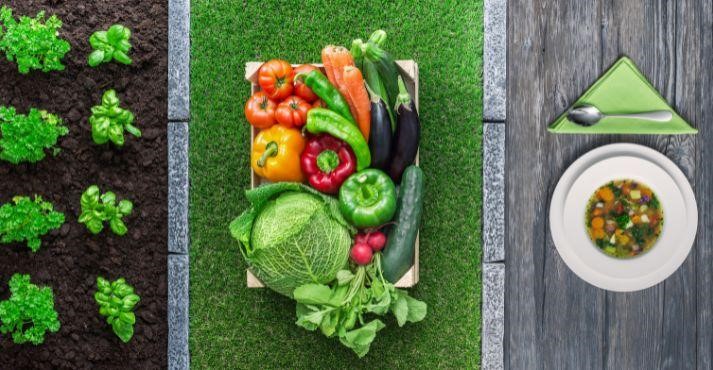In Southeast Asia, the farm-to-table dining movement is gaining momentum, revolutionizing how we approach food. Farm-to-table is a commitment to sourcing fresh, locally grown ingredients directly from nearby farms to our dining tables. This practice ensures the highest quality and taste and promotes sustainable food practices.
Farm-to-table dining becomes increasingly relevant as the demand for healthier, more environmentally friendly food options rises.
Recent statistics reveal a surge in consumer interest, such as a 30% increase in farm-to-table restaurants in the past five years, making it clear that this trend is more than just a fad.
Farm-to-table dining creates a deeper connection between consumers and their food by supporting local agriculture and communities. Let’s explore the growing popularity and positive impact of farm-to-table dining in Southeast Asia.
What is Farm-to-Table Dining?
Farm-to-table dining is a simple yet powerful concept that involves bringing fresh, seasonal ingredients straight from local farms to the table. It’s about keeping things close to home, celebrating the bounty of each season, and savoring the flavors of locally grown produce.
Instead of relying on ingredients that have traveled long distances, farm-to-table restaurants prioritize sourcing from nearby farms, ensuring that food is at its peak freshness and flavor.
This dining concept has its roots in the 1960s and 1970s, particularly in California, where chefs and food enthusiasts began to question the industrialized food system. They wanted to know where their food came from and how it was grown.
This sparked a movement towards more sustainable, locally sourced ingredients. Over time, the farm-to-table concept has evolved into a global culinary trend, with restaurants worldwide incorporating its principles of freshness, seasonality, and quality.
Today, farm-to-table dining isn’t just about enjoying a delicious meal; it’s also about supporting local farmers, reducing carbon footprint, and developing a deeper connection with our food.
By choosing farm-to-table restaurants, diners can feel good knowing that they’re not only treating themselves to a great meal but also positively impacting their community and the environment.
Benefits of Farm-to-Table Dining

Farm-to-table dining is about more than enjoying delicious meals; it’s about making a positive impact on our communities and environment. Let’s uncover the many benefits of choosing farm-to-table options for your dining experience.
For Consumers and Restaurants
- Fresher and more nutritious ingredients: With farm-to-table dining, consumers can enjoy meals made with locally sourced, seasonal produce harvested at its peak freshness. This ensures that dishes are tastier and packed with essential nutrients.
- Support for local farmers: By choosing farm-to-table options, consumers directly support local farmers and producers, helping to sustain their livelihoods and strengthen local food systems.
- Reduced carbon footprint: Farm-to-table dining minimizes the distance food travels from farm to table, reducing transportation emissions and environmental impact. This contributes to a healthier planet and supports sustainable living practices.
For the Environment
- Food security: Farm-to-table practices promote food security by reducing dependence on imported food and ensuring a reliable supply of fresh, locally-grown This helps safeguard against food shortages and disruptions in the supply chain.
- Biodiversity preservation: Farm-to-table dining encourages biodiversity preservation by promoting the use of locally sourced and indigenous ingredients. This supports the conservation of native plant varieties and traditional farming practices, contributing to ecosystem resilience.
- Cultural heritage conservation: Farm-to-table practices also help conserve cultural heritage by preserving traditional farming methods and culinary traditions. By adopting local cuisine and ingredients, farm-to-table dining helps celebrate and preserve Southeast Asia’s rich culinary heritage.
Farm-to-Table Movement in Southeast Asia
In Southeast Asia, the farm-to-table movement is gaining traction as more people recognize the value of fresh, locally sourced ingredients.
This region boasts a rich agricultural heritage, with diverse climates and fertile lands ideal for cultivating various crops. Southeast Asia’s bounty is unmatched, from tropical fruits to aromatic spices and fragrant herbs.
Across the region, there has been a notable increase in restaurants and initiatives embracing sustainable sourcing practices.
According to recent statistics, the value of farm-to-table restaurants in Southeast Asia will be USD 622 billion, reflecting a growing demand for wholesome, ethically sourced food.
Key players and organizations are driving the farm-to-table movement forward in Southeast Asia. Farmers’ cooperatives are crucial in connecting local farmers with restaurants and consumers, ensuring a steady fresh produce supply.
Organizations like the Asian Farmers Association for Sustainable Rural Development and the ASEAN Farmers’ Organisation Support Programme actively promote sustainable agriculture practices and support small-scale farmers in the region.
Organic markets provide a platform for farmers to showcase their products directly to consumers, promoting transparency and supporting small-scale growers. Examples include the Organic Farmers’ Market in Bangkok and the Ubud Organic Market in Bali.
Culinary schools also contribute to the farm-to-table movement by educating aspiring chefs about the importance of sustainable sourcing and responsible cooking practices.
Institutions such as Le Cordon Bleu Thailand and At-Sunrice GlobalChef Academy in Singapore incorporate farm-fresh ingredients into their curriculum, shaping the next generation of chefs committed to supporting local agriculture and preserving the region’s culinary heritage.
Overall, the farm-to-table movement in Southeast Asia is more than just a passing trend – it’s a cultural shift towards more conscious eating habits and a deeper connection to the land.
Challenges in Farm-to-Table Dining

Implementing farm-to-table practices in Southeast Asia comes with its share of challenges for both restaurants and farmers:
1. Higher food costs:
- Locally sourced ingredients may come at a higher price compared to imported goods.
- Limited access to affordable organic farming methods can also contribute to increased production costs for farmers.
2. Logistics and distribution:
- Ensuring timely delivery of fresh produce to restaurants can be challenging, especially in remote areas.
- Lack of proper infrastructure and transportation options may lead to delays and quality issues.
3. Market access:
- Small-scale farmers often need help accessing markets due to limited resources and knowledge of market demands.
- Competition from larger suppliers and distributors can further hinder their ability to reach consumers directly.
4. Consumer education:
- Many consumers may need help understanding the value of farm-to-table dining or the benefits of locally sourced ingredients.
- Misconceptions about organic farming practices and the perceived superiority of imported goods can present barriers to adoption.
Solutions and Best Practices
1. Collaborative partnerships:
- Restaurants can partner directly with local farmers to negotiate fair prices and ensure a steady supply of fresh produce.
- Cooperative initiatives between restaurants, farmers’ associations, and government agencies can help modernize distribution channels and reduce costs.
2. Farmer training programs:
- Providing farmers with training programs on sustainable farming practices, crop diversification, and post-harvest handling can improve quality and yield.
- Government-funded initiatives and NGO partnerships can offer support and resources to help farmers overcome technical and financial barriers.
3. Public awareness campaigns:
- Restaurants and agricultural organizations can collaborate on public awareness campaigns to educate consumers about the benefits of farm-to-table dining.
- Promoting locally sourced ingredients’ environmental, economic, and health benefits can help shift consumer preferences and support demand for sustainable food options.
Examples of Farm-to-Table Restaurants in Southeast Asia
Exploring farm-to-table restaurants in Southeast Asia means diving into a world of fresh, local flavors from nearby farms. What is farm-to-table? It’s all about enjoying meals made with ingredients grown in the region, ensuring tasty and healthy dining experiences.
Let’s look at some great examples of farm-to-table restaurants in Southeast Asia.
1. Open Farm Community, Singapore

Open Farm Community in Singapore is like a cozy restaurant tucked away in a magical garden. They believe in using fresh ingredients from nearby farms to make tasty food. Their kitchen is open, so you can see chefs cooking up yummy dishes.
They care about the environment, so they try not to waste water or electricity and use less plastic. They also have fun events where you can learn about farming and try gardening yourself.
Open Farm Community is about enjoying good food while caring for the planet. It’s a special place where you can eat, live, and have fun with friends and family!
2. Labyrinth, Singapore

At Labyrinth, Chef LG Han cooks food that reminds him of home. He uses ingredients from Singapore to make delicious and familiar dishes. Labyrinth has won a Michelin star for its fantastic food. Each dish tells a story, mixing old recipes with new ideas.
With every bite, it’s like taking a trip back in time. When you eat at Labyrinth, you taste Singapore’s heart and soul. It’s a special place where food brings people together, and memories come alive. So, to experience the magic of Singaporean flavors, go to Labyrinth and let your taste buds take a trip.
3. Dewakan Restaurant, Kuala Lumpur

Dewakan is a unique restaurant in Kuala Lumpur that celebrates Malaysian flavors and culture. In Malay, the name means “god” and “food,” which shows how much they love good food.
At Dewakan restaurant, fresh ingredients from Malaysia are used to create delicious dishes that tell stories. Their amazing food even won two Michelin stars! If you visit Dewakan, you can try their special tasting menu, which changes with the seasons.
They also have special drinks that go perfectly with their food. Dewakan is the perfect place for a special meal with friends or family.
4. Haoma, Bangkok

Haoma is more than just any restaurant in Bangkok. It’s unique because it’s the city’s first urban farm and zero-waste restaurant. What does that mean? This means they care a lot about the environment and the food they serve and produce zero waste.
The name “Haoma” comes from the combination of Malay words for “god” and “food,” showing how much they love good food and want to make the world a better place.
The chef, Deepanker Khosla, is like a champion for sustainability and delicious flavors. He won awards for his fantastic work, including a Michelin star.
He’s not just a chef; he’s a champion of change. Haoma serves food that’s tasty and good for the planet. They even grow some of their ingredients right in their garden.
5. The Hideout, Koh Lanta

At The Hideout, guests delight in authentic, organic dishes showcasing the vibrant flavors of southern Thailand. The menu caters to diverse tastes, including indulgent options for foodies, vegetarian and vegan choices, and halal selections, so there’s something for everyone.
Traditional spices and hand-crafted tonics complement fresh seafood and locally sourced produce. The restaurant’s commitment to sustainability shines through its farm-to-table philosophy and zero-waste practices.
Guests enjoy breathtaking sunrise and sunset views while engaging in a culinary experience where Thai traditions meet Western influences. Through community-focused initiatives, The Hideout has a welcoming environment, inviting guests to be part of something bigger as they savor every bite.
6. Green Village Restaurant, Bali

Enjoy farm-to-table dining at Green Village Restaurant, where every dish features fresh ingredients sourced from the lush Balinese forests. Its eco-friendly bamboo structures, carefully crafted by the IBUKU team, offer a luxurious yet sustainable backdrop for your dining experience.
The community welcomes investors and nature enthusiasts conveniently located near the prestigious Green School.
Impact and Future
Cultivating a Sustainable Culinary Landscape through farm-to-table
Farm to Table isn’t merely a trend – it’s a transformative force that has left an indelible mark on the culinary landscape. Its impact reaches far beyond the plate, shaping our choices, practices, and the future of dining.
Sustainable Culinary Landscape
The Farm to Table movement has sowed the seeds of change, cultivating a sustainable culinary landscape that resonates with environmental consciousness. As diners become more discerning, their preferences shift towards ethical and eco-friendly dining choices.
This shift, in turn, compels restaurants and food establishments to adapt, promoting sustainable practices that echo the values of their patrons.
One of the movement’s remarkable impacts is its role in encouraging sustainable farming practices.
Local sourcing, a central tenet of Farm to Table, supports nearby farmers and promotes farming methods that respect the earth.
It’s a step towards ethical dining – a deliberate choice to consume food that has been cultivated with care for the environment.
Farm to Table paves the way for ethical and eco-friendly dining, shaping a future where every meal is a conscious choice.
Diners are no longer mere consumers but stewards of a greener tomorrow. By embracing Farm to Table, we embrace a lifestyle that’s more than a trend – it’s a commitment to a sustainable and flavorful journey that extends well beyond the confines of the dining table.
Future Prospects
The future of Farm to Table holds the promise of an ever-evolving culinary landscape.
We can anticipate a continued emphasis on local sourcing and seasonal ingredients, as these practices forge a genuine connection between consumers and the land.
Yet, the movement’s evolution extends beyond the soil – it’s a journey toward embracing new flavors, techniques, and cultural fusions that enrich the dining experience.
Technological Integration and Culinary Transformation
Technology, an ever-present force in our lives, is poised to intertwine with Farm to Table.
From streamlined digital menus that highlight seasonal offerings to smart sourcing systems that connect diners directly with farmers, technological integration promises to enhance transparency and accessibility.
This fusion of innovation and tradition brings us closer to the source, empowering us to make informed choices while relishing in the delights of a rapidly changing culinary landscape.
The future trends of Farm to Table might encompass diverse dimensions – from precision agriculture that optimizes crop cultivation to immersive dining experiences that celebrate cultural heritage.
As we anticipate the unfolding chapters, one thing is clear: Farm to Table is not just a movement; it’s an ever-unfolding story of culinary transformation that invites us all to be active participants in the narrative.
Conclusion
The journey through Farm to Table has been an exploration of culinary values that resonate deeply in a world seeking sustainability and authenticity.
This movement has taken us on a profound voyage, unveiling the beauty of sustainable, locally sourced, and transparent dining experiences.
As we reflect on the significance of Farm to Table, we celebrate its ability to redefine our relationship with food, enrich our culinary experiences, and contribute to a brighter future.
Farm to Table is more than a philosophy – it’s a celebration of the art of connection. It bridges the gap between the farmer’s toil and the diner’s delight, underscoring the shared narrative that links each ingredient to the land it comes from.
This movement champions the importance of knowing the story behind our food, inviting us to cherish the tales of origin that infuse each dish with meaning.
Transparency in sourcing, a cornerstone of Farm to Table, empowers us to make eco-friendly choices, aligning our values with our consumption.
This shift towards conscious dining echoes the global call for sustainability, and Farm to Table stands as a resounding answer – a culinary commitment to the well-being of our planet.
In essence, Farm to Table is a journey of rediscovery – of flavors, stories, and values that have always been a part of our culinary heritage.
As we conclude this exploration, we embrace the legacy of Farm to Table, a movement that extends an invitation to savor the delectable delights on our plates and the shared commitment to a more sustainable, connected, and enriching dining experience.





























